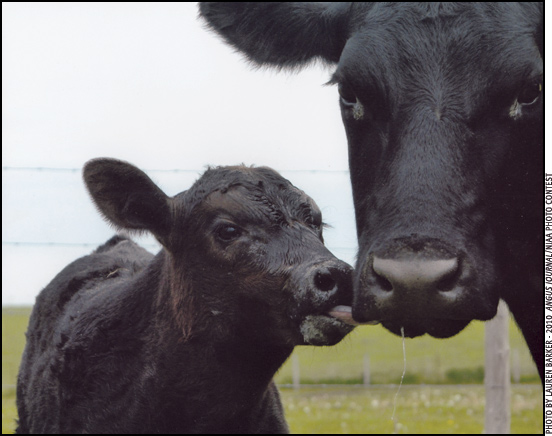Angus Releases
Heifer Pregnancy EPDs
And, CED EPDs are now enhanced with genomic information.
After years of collecting breeding records, the American Angus Association has introduced a genetic selection tool to help Angus breeders and their customers better identify animals with desirable reproductive ability. The heifer pregnancy expected progeny difference (HP EPD) will measure the chance of a sire's daughters becoming pregnant during a normal breeding season.
HP EPDs are developed using breeding records, pregnancy-check and calving data, as well as pedigree information. The unit of measure for the EPD is a percentage — a higher EPD is more favorable.
"In this case, when comparing two sires on heifer pregnancy EPDs, a higher-EPD sire would be expected to have daughters with a greater probability or chance of becoming pregnant than a sire with the lower EPD," explains Sally Northcutt, Association director of genetic research. Read more.
A Reason to Plan
Repeal of Ohio Estate Tax concerns transition planning professionals.
Commonly referred to as the "death tax" by critics, estate tax is one of the more controversial issues in ag policy circles, said an Ohio State Extension ag law expert. Ohio's version of this tax provision is set to expire due to a provision in the state's biennial budget — a prospect that concerns financial planning professionals.
"The primary concern is that the repeal, along with changes in the federal estate tax will serve as a disincentive to doing farm transition, business and estate planning," said Peggy Hall, director of the Agricultural and Resource Law Program of Ohio State University Extension. "That's the concern I'm hearing from many attorneys." Read more.

Bryce Schumann
Association Perspective
It's a small world after all.
The Angus world comes together for two events this fall that afford the opportunity to network with others in the Angus business, learn and see new things, and renew old friendships and business contacts.
The first is the National Angus Conference & Tour (NAC&T), which is fast becoming one of the most popular events in the Angus business. Last year's event in Montana hosted more than 800 breeders from across the country and around the world, and included a tour of some of the most picturesque and progressive ranches in America.
This year's conference and tour, which takes place Sept. 6-8 in Athens, Ga., is likewise shaping up to be one of the best ever.
The daylong conference includes a top-flight slate of educational seminars, panelists and well-known keynote speaker Bruce Vincent, a third-generation logger from Libby, Mont.
The tour takes participants on a two-day trip across the state to visit some of Georgia's leading Angus operations and other agricultural centers. The early registration deadline is Aug. 1. Read more.

Protecting Range for the Birds
USDA to protect prime sage-grouse habitat in three western states.
The U.S. Department of Agriculture (USDA) will provide approximately $18.2 million in additional financial assistance to help eligible ranchers in Idaho, Utah and Wyoming conserve critical sage-grouse habitats through the Grassland Reserve Program (GRP), Ag Secretary Tom Vilsack announced.
"USDA and its partners are taking a proactive approach to maintaining large and intact grazing lands that support healthy sage-grouse populations," Vilsack said. "GRP will provide these states with another tool to conserve this at-risk species and also protect important ranch lands."
GRP, a voluntary program, allows ranchers and farmers to limit future development of the land while retaining the right for landowners to conduct common grazing practices and operations using rental contracts and conservation easements. USDA directs financial resources and technical expertise to help landowners protect and restore these lands. USDA's Natural Resources Conservation Service (NRCS) and Farm Service Agency (FSA) administer GRP. Read more.
Drought Ramifications
Drought to have multiyear effect on rebuilding of the U.S. cow herd.
Ongoing drought conditions in the Southern Great Plains states make it increasingly likely the rebuilding of the U.S. cow herd will take four years or more.
For the year to date, beef cow slaughter decreased 4.4% nationally, while beef cow slaughter in Region 6, which closely corresponds to the drought area, increased 11.7%.
Derrell Peel, Oklahoma State University (OSU) Cooperative Extension livestock marketing specialist, said the contrast between beef cow slaughter nationally, and in the drought region clearly indicates that the effects are significant. Read more.
What’s Inside …
In this July edition of the Angus Beef Bulletin EXTRA, you'll find valuable articles devoted to the management, marketing, and health and nutrition of your beef enterprise. Select from the tabs at the top of the page to access this month's entire offering by category. A few select features include:
- Cow Camp Chatter: Leasing cows
- Beef Talk: Bulls furloughed until mid-August
- Summer's Heat Means Watching Cattle for Heat Stress
- Ridin Herd: Drought & Forage Quality
- Unloading Mycoplasma bovis
- Culling Hard
- Traceability Name of Global Market
News Briefs …
The American Angus Association and its subsidiaries generate a wealth of information to keep members and affiliates informed of what's happening within the industry as well as with the programs and services they offer. Click here for easy access to the newsrooms of the American Angus Association and Certified Angus Beef LLC and the Angus e-List archive.
A Deeper Look
Cutting farm direct payments might not save as much as first appears, MU FAPRI reports.
Cutting direct payments to farmers appears to save $4.9 billion per year in the federal budget. However, cutting that U.S. Department of Agriculture (USDA) program could boost farmer participation in ACRE, a program that offsets losses in farm income.
"Much of the budget savings from cutting direct payments could be offset by sharp increases in ACRE program expenditures," says Pat Westhoff, director of the University of Missouri Food and Agricultural Policy Research Institute (MU FAPRI).
A report released today compares payment cuts to expected expenditures in the 2012 MU FAPRI baseline. The think tank maintains computer models of the farm sector. Read more.
Tips to Combat Heat-related Illnesses
The risk of heat-related problems increases with age.
Older people can face risks related to hot weather. As people age, their bodies lose some ability to adapt to heat. They may have medical conditions that are worsened by heat. And their medications could reduce their ability to respond to heat.
The National Institute on Aging (NIA), part of the National Institutes of Health (NIH), has some advice for helping older people avoid heat-related illnesses, known collectively as hyperthermia.
Hyperthermia occurs when the body overheats. Conditions involving hyperthermia have different names, including heat stroke, heat fatigue, heat syncope (lightheadedness or fainting in the heat), heat cramps and heat exhaustion. Read more.
[Click here to go to the top of the page.]













